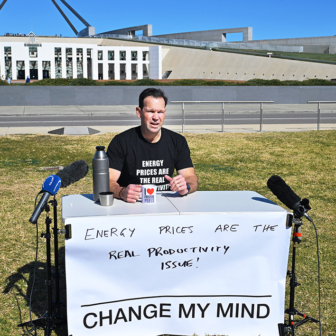JUST as financial accounts tell us useful information about a company’s business, carbon accounts tell us useful information about a country’s domestic emissions. Financial accounts inform, but do not determine, a company’s business strategy. Strange, then, that domestic carbon accounting dominates the climate strategy of Australia and many other countries.
Under rules agreed within the UN climate change regime, countries have a legal obligation to account for certain types of emissions that occur within their national borders. These accounting obligations arguably make sense as a means of efficiently distributing the burden of measuring global emissions and reporting the data for the purpose of achieving a reasonably accurate global picture of the extent and geographic location of greenhouse gas emissions.
Unfortunately, instead of serving merely as a useful input into the formulation of climate policy and the debate surrounding it, the data generated from such accounting has become a severe constraint on our thinking about this most important topic. When we think about Australia’s contribution to global warming, we tend to think only about the “1.5 per cent of global emissions” – 560 million tonnes of carbon dioxide equivalent (MTCO2-e) – released within our borders. Likewise, when it comes to reducing emissions, Australian politicians and policy-makers consider only these domestic emissions.
Such a limited response to the urgent threat of climate change might make sense in one scenario: the ideal world of the climate change policy-maker. In this world, every country would have a legally binding target for reducing its domestic emissions; those targets would “add up” to the cuts required to ensure the world’s greenhouse gas pollution falls within safe atmospheric limits; and compliance with those targets would be vigorously enforced. In these circumstances, Australia could justify its fossil fuel exports on the ground that other countries were combusting those fuels in the context of a comprehensive regime of “safe” emissions limits.
But no such regime exists today, and nor is one likely to emerge in the foreseeable future. There are currently no international controls in place to ensure the volume of fossil fuels being traded is consistent with a safe climate outcome. Even if countries were to negotiate and implement an international climate treaty based on the Durban Roadmap, agreed by the international community late last year, the best-case scenario would be far too little, far too late to ensure global emissions peak and begin to decline as is required in this “critical decade” of climate change. It therefore no longer makes sense for us to confine our conception of a country’s role in tackling climate change to its domestic emissions.
In reality, emissions reductions (at least for the foreseeable future) will only occur through a more complex patchwork of arrangements and in multiple different ways. So how should we think about our national climate strategy and policy in the context of this messy world of “bottom-up” action?
BEFORE we think about what a single country should do, let’s consider what a country can do; let’s examine the emissions-causing economic and social processes that fall within a country’s “sphere of influence.”
In our globalised economy, a country can engage in a whole range of actions that exclusively or partially cause greenhouse gas emissions somewhere in the world. Consider the example of “Country A” and the emissions associated with coal in the following four activities:
1. A company in Country A extracts and combusts some of its own coal to produce electricity that is supplied to nearby households;
2. Another company in Country A exports some of its coal to be combusted in Country B;
3. A citizen of Country A imports a consumer product from Country C, the production of which required the combustion of coal in country C; and
4. A company in Country D extracts and combusts some of its own coal to produce electricity that is supplied to nearby households.
The emissions from the first activity are exclusively attributable to Country A, since no other countries were proximately involved in the supply chain of the electricity. In the second and third activities, Country A is a partial or contributory cause of the emissions created in the course of each (along with Countries B and C, respectively). In the fourth activity, Country A does nothing to cause these emissions (only the actions of Country D are causally significant), but Country A might nonetheless be able to prevent those emissions from occurring.
It can be seen from these examples that every tonne of greenhouse gas emitted in the world can be conceptualised as lying on a spectrum that measures the degree of control or influence a particular country has over its production. In the case of “purely domestic” emissions (such as example 1, above), a country has full control over those emissions. Similarly, a country has full control over the emissions embodied in its fossil fuel exports (example 2). A country also has full control over whether it imports particular goods and services, along with some influence (though not full control) over the emissions caused overseas as a result of the production of goods and services that it does decide to import (example 3). All of these emissions fall within a country’s “sphere of influence” – and this is the case irrespective of whether they also fall within another country’s sphere of influence.
It could also be argued that a quantum of overseas emissions falls within a country’s sphere of influence if that country possesses financial, technological or other capabilities that could be applied to prevent those emissions from occurring. In example 4, above, Country A might have access to the financial capital, intellectual talent and other capabilities necessary to develop and commercialise a particular renewable energy technology that can be used as a zero-carbon substitute for coal-fired electricity in Country D. The government of Country A may also be in a position to negotiate an arrangement by which that technology can be deployed in Country D in circumstances where private markets would not be able to achieve that result. Country A’s ability to influence the relevant emissions in Country D brings those emissions within Country A’s sphere of influence, even though that influence may be less direct than in the first three examples.
It can readily be seen from this discussion that the quantum of emissions over which a country has influence is far greater than its mere domestic emissions. As such, the sphere of influence approach provides a much more realistic picture of a country’s causal contribution to, and ability to influence, climate change.
This raises two important questions: for which combination of emissions within a country’s sphere of influence should a country be held accountable? And which emissions should it be responsible for reducing?
It is particularly pertinent to ask these questions in Australia. Today, twice as much greenhouse gas is embodied in the fossil fuels Australia exports than is produced through burning fossil fuels at home. The world’s largest coal exporter and fourth-largest exporter of liquefied natural gas, or LNG, we export more greenhouse gas than every nation bar Saudi Arabia and Russia. Moreover, Australia is currently undergoing an immense, government-backed expansion of coal and LNG exports, which is projected to double our exported emissions by 2030.
Some Australian companies, people and government entities receive significant benefits from this activity. Australia has sovereignty over its natural resources, and state and federal governments possess the legal authority to determine whether, and the extent to which, those resources may be extracted, used and exported. (Although mineral resources are vested in state governments, the federal government has the power to make laws with respect to, among other things: trade and commerce with other countries; corporations; and “external affairs.”) Australian governments also have the capacity to determine how much to subsidise resource exploitation. In light of these realities, should Australia be held (at least partly) accountable for our exported emissions? Given what we know about climate change and the urgent need to cut global emissions, should we refrain from expanding these exports and start winding them back?
Australian people and companies also import a large amount of goods and services, such as motor vehicles and electronic equipment, the production of which causes emissions (largely from electricity used in the manufacturing process). Subject to international law, the Australian government has the power to control and regulate the range of goods that enter through Australia’s borders, for example by requiring importers to hold licences, imposing quotas or tariffs on imports, or prohibiting the import of certain goods altogether. Although it cannot directly control the emissions intensity of overseas-produced goods and services, the government can certainly take action that has an indirect effect on overseas emissions. This could include border tax adjustments on emissions-intensive imported goods, or domestic policies (such as environmental labelling or regulation) that help induce a structural shift away from emissions-intensive imports. Should we impose such policies? Should we at least be held accountable for the emissions caused by our imports?
Australia also enjoys world-class solar, wind and other renewable resources, along with outstanding financial and technical capabilities that enable us to provide leadership in the development and deployment of critical renewable energy technologies. Do we have a responsibility to invest in reducing the cost of these technologies or subsidising their diffusion in the developing world? Given the urgent need for these technologies, should we be held accountable for failing to take such action?
These are difficult questions, but they are questions that urgently require answers.
AS WITH most international issues we face today – from financial crises to global poverty to nuclear proliferation – responsibility for emissions in a globalised world cannot be so easily quantified and demarcated at national borders. Conceptually, there is a strong case to be made that moral responsibility for the causation of a particular tonne of emissions should be attributed to those countries whose economic activity caused it. This means responsibility for the emissions caused by traded goods would be shared between the importing country and the exporting country on the basis that each contributed to causing those emissions and each derived benefits from the associated economic activity.
In practice, it is likely to prove difficult to establish a coherent, legalised carbon-accounting regime that avoids “double counting” emissions on the basis of this form of “shared responsibility.” But this is beside the point: the soundness of the underlying conceptual logic makes this approach useful for informing national policy decisions about climate change in a world that lacks a comprehensive international emissions reduction regime.
Specifically, four consequences flow from thinking about climate policy on the basis of shared responsibility for emissions within countries’ spheres of influence. First, the focus of a country’s policy response expands from “domestic emissions only” to its entire sphere of influence. Second, the focus shifts to the (often transnational) economic and social processes that cause emissions, as opposed to the tonnes of emissions resulting from those processes that happen to fall within one country’s border or another’s. Third, a much larger menu of unilateral and cooperative policies and measures becomes relevant. Fourth, this approach would enable a nuanced differentiation of responsibilities between countries with differently sized spheres of influence, different capabilities and different historical contributions to climate change.
Thinking about responsibility in this way would, for example, imply a shift in Australia’s policies regarding fossil fuel exports. We could no longer think of our fossil fuel exports as “someone else’s problem.” We would instead need to work with importing nations to decarbonise the underlying energy generation and transport processes using a wide range of policies and measures. And we would need to shoulder greater costs than lower-income countries as part of this process of “cooperative decarbonisation.”
When it comes to climate change, no country is an island. It’s time to move beyond the narrow confines of technical compliance with domestic emissions accounting rules and think about the true scope of our power to influence the global emissions trajectory – for better or for worse.




